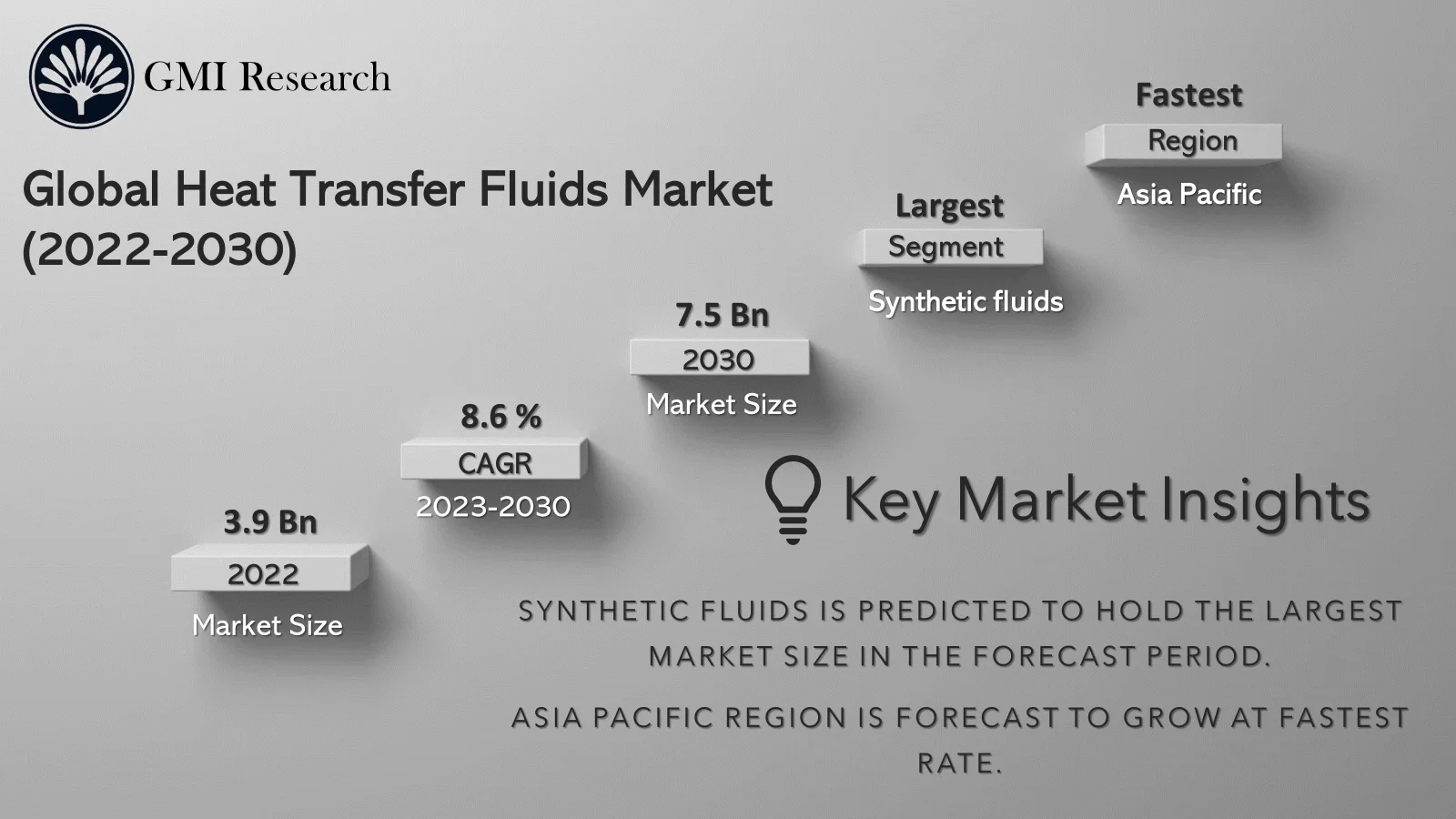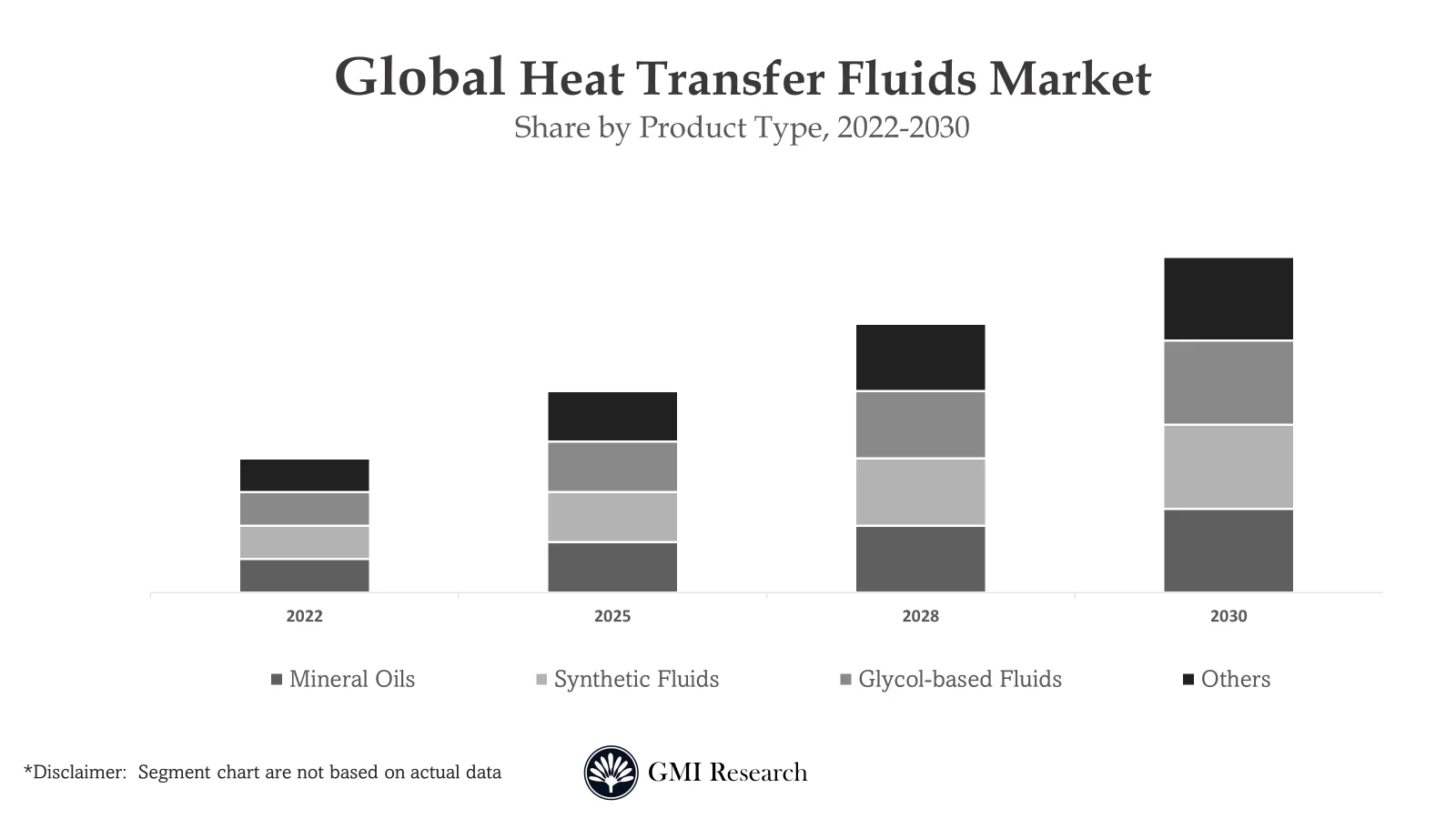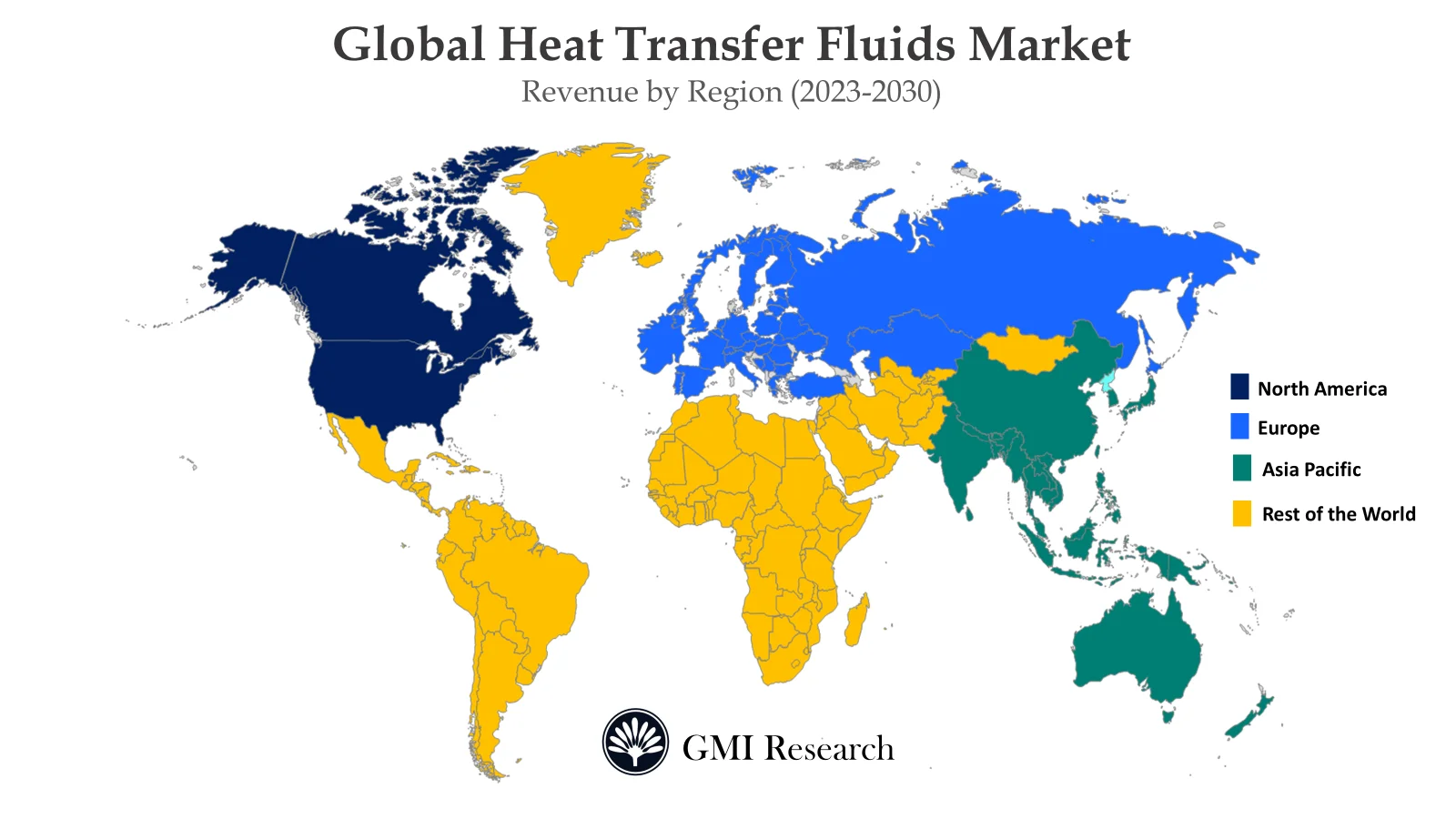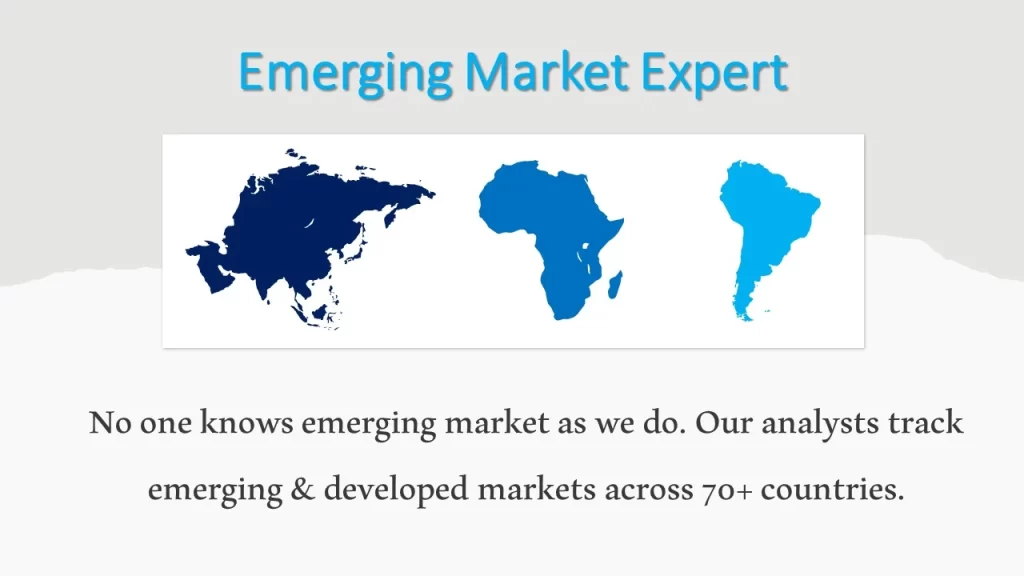Heat Transfer Fluids Market Size, Share, Trends and Growth Report – Global Opportunities & Forecast, 2023-2030
Analysts at GMI Research estimates that the Heat Transfer Fluids Market was worth USD 3.9 billion in 2022, and forecast to touch USD 7.5 billion in 2030, growing at a CAGR of 8.6% from 2023-2030.

To have an edge over the competition by knowing the market dynamics and current trends of “Heat Transfer Fluids Market”, request for Sample Report here
Major Heat Transfer Fluids Market Drivers
The primary drivers that drive global heat transfer fluids market are increase in the adoption of solar power systems, the rapid rise in demand for heat transfer fluids from different industries such as oil & gas, automotive, and other for heat transfer applications, and a growing need for power in evolving as well as developed nations. The heat transfer fluids, derived from petroleum sources, play an important role in preventing overheating and storing thermal energy in industrial procedures. The production of these fluids involves key raw materials such as silica, base oils, and crude oil. The features of a heat transfer fluid include non-corrosive properties, diffusivity, high thermal conductivity, and low viscosity, coupled with the ability to withstand extreme phase transition temperatures. It is traditionally used for heat transfer in the process stream, picking the right heat transfer fluid is now a complex decision. Factors including thermal stability, pressure demands, and pumpability needs are considered. Heat transfer fluids play an important role in different applications, varying from separating heat from the sun in determined solar panels to managing oil & gas in cold climate conditions.
In addition, the Asia Pacific region presents a lucrative market for heat transfer fluids. The robust industrialization witnessed in emerging nations such as India, and China is propelling a substantial need for heat transfer fluids. Key producers in the heat transfer fluid industry, including Hindustan Petroleum Corporation Limited, Dalian rich Fortune Chemical Company, Dow, and Indian Oil Corporation, are engaging strategic approaches such as developments and product launches to expand their existence in the Asia Pacific heat transfer fluids market. The renewable energy sector is predicted to rise in the heat transfer fluid market around the region, specifically in India. The growing implementation of renewable energy sources for environmental conservation, economic benefits, and social development is a foremost factor contributing to the increased growth of the APAC HTF market. The GOI is actively encouraging the usage of green energy in the manufacturing segment through supportive policies. For instance, Pradhan Mantri Kisan Urja Suraksha Evam Utthan Mahabhiyaan have been launched to boost the usage of solar and other renewable sources, with a goal of adding 25,750 MW by 2022. This concerted effort is propelling an increased need for heat transfer fluids across the country.
In the U.S., which is a significant contributor to global Concentrated Solar Power capacity, the usage of heat transfer fluid is a strategic component of developing the effectiveness of CSP plants. These fluids play an important role in asserting energy from the solar field and carrying it to energy storage systems, confirming optimal power output during high need. The stored energy in concentrated solar power plants enables electricity generation even after sunset or throughout cloudy weather. CSP systems, with the ability to add six additional hours to storage compared to PV systems, present functional value, supporting the growth and substantial implementation of heat transfer fluids in the CSP segment, predicted at USD 35.8/MW. Moreover, heat transfer fluids are also significantly utilized in the U.S. oil & and gas industry, which increasingly contributes to the nation’s economy. With the predicted rise in natural gas, and liquid production owing to shale resource development, there is an increase in heat transfer fluids demand.
Meanwhile, the aging procedure of heat transfer fluids can be complex. At elevated temperatures, thermal cracking takes place, causing the breakdown of oil molecules and the foundation of coke. This phenomenon can lead to a deduction in flashpoint and viscosity, thereby increasing vapor pressure in the fluid. Moreover, monitoring the flashpoint and regularly conducting health checks on the system and functioning fluid is important for producers. This helps recognize potential problems connected to thermal cracking, hotspots, and coke formation that could lead to damage to the metal surfaces in the system.
Do you want to know more about the Research process and detailed Methodology, Request Research Methodology of this report
Whereas, presently, the need for increased productivity in industries has led to higher functioning temperatures and developed pressure demands for heat transfer fluid systems, reflecting the evolving difficulties faced by these sectors. Industries functioning around the clock, such as the chemical and petrochemical segments, present a need for heat transfer fluids, highlighting their significant role in ongoing production procedures. In high-temperature industries, heat transfer fluids have become indispensable because it develops energy effectiveness, regulating temperature, confirming reliability, and maintaining functional safety.

The global heat transfer fluids market is witnessing growth due to the growing need for these fluid-efficient energy solutions and their widespread adoption in industrial procedures. The growing demand for heat transfer fluids is closely tied to the global shift towards sustainable and renewable energy solutions. Industries identify the significance of these fluids in developing energy effectiveness and assisting eco-friendly exercises. Solar thermal systems leverage heat transfer fluids to effectively grasp and carry solar energy. The wider force to decrease carbon emissions aligns with the implementation of heat transfer fluids to develop energy effectiveness in different industries.
Synthetic fluids segment dominated the global market
Synthetic fluids outperform mineral oils owing to their resistance to oxidation, oil sludge issues, and thermal breakdown, offering decreased evaporation losses. Their molecular structure and strong bonds enhance thermal stability and durability, presenting an enhanced viscosity index. Whereas, they are environmentally friendly which results in less oil waste, while there are costly as compared to mineral oils.
Renewable energy industry accounted for the largest share in the global heat transfer fluids market
Heat transfer fluids find application in solar power plants, biodiesel production systems, geothermal systems, and wind turbines. In addition, they play an important role in storing solar energy, confirming a steady power supply despite intermittent sunlight. It is predicted that the growth in the renewable energy is propelled by government regulations on clean energy and an increase in solar energy need, is likely to foster the heat transfer fluid market.
In case, any of your pain points areas are not covered in the current scope of this report, Request for Free Customization here
Asia Pacific region expected to grow at fastest CAGR in the global heat transfer fluid market
Easy availability of low-cost raw material, an increase in domestic demand, and abundant labor make the region a fascinating investment destination for heat transfer fluid producers. Factors such as an increasing population, rising emphasis on energy infrastructure development in developing nations such as China and India, and rapid industrialization are predicted to foster the heat transfer fluid market growth in APAC. Moreover, Mexico chemical industry is witnessing substantial investment and a continuous availability of different raw materials to fortify its core. The country’s rapid industrialization, along with increased chemical trade to NAFTA countries, is predicted to foster the heat transfer fluids demand. In addition, Mexico has a considerable existence in the plastic manufacturing industry.

Europe is predicted to be the fastest-growing region in the global heat transfer fluids market
Europe is predicted to present steady growth in the global heat transfer fluids market due to increasing population, coupled with growing energy requirements. Additionally, an expansion in energy and power sectors present a positive market expansion. Germany and Spain register the market share in Europe, propelled by industrial expansion. The region is estimated to observe the establishment of more solar power facilitates shortly is estimated to drive the Europe heat transfer fluids market.
Top Market Players
Various notable players operating in the market include Dynalene, Inc., Indian Oil Corporation Ltd. (IOCL), KOST USA, Inc., Hindustan Petroleum Corporation Ltd. (HPCL), Delta Western, Inc. (DWI), British Petroleum (BP), Huntsman Corporation, Royal Dutch Shell Plc, Eastman Chemical Company, Phillips 66, Chevron Co., BASF SE among others.
Key Developments:
-
- In 2023, ORLEN Poludnie completed the first operating year for its BioPG plant, transforming glycerol into a renewable propylene glycol which is a by-product of biodiesel.
- In 2023, Chevron and JERA signed an MOU to discover carbon storage and capture projects around the US and Australia.
- In 2022, Eastman announced an expansion of its Eastman Therminol 66 HTF manufacturing facility across Anniston, Alabama to address the growing requirements of customers globally.
- In 2022, LANXESS and Standard Lithium joined hands to be competitive in the market and develop a path toward the Lithium project.
- In 2019, Eastman acquired Marlotherm HTFs manufacturing assets located in Germany, which has helped both the players in expanding the geographical presence.
Segments covered in the Report:
The Global Heat Transfer Fluids Market has been segmented on the basis of Product Type and End Use. Based on the Product Type, the market is segmented into Mineral Oils, Synthetic Fluids, Glycol-based Fluids, Others. Based on the End Use, the market is segmented into Chemical & Petrochemical, Oil & Gas, Automotive, Renewable Energy, HVAC, Pharmaceutical, Others.
For detailed scope of the “Heat Transfer Fluids Market” report request a Sample Copy of the report
|
Report Coverage |
Details |
| Market Revenues (2022) |
USD 3.9 billion |
| Market Base Year |
2022 |
| Market Forecast Period |
2023-2030 |
| Base Year & Forecast Units |
Revenues (USD Billion) |
| Market Segment | By Product Type, By End Use, By Region |
| Regional Coverage | Asia Pacific, Europe, North America, and RoW |
| Companies Profiled | Dynalene, Inc., Indian Oil Corporation Ltd. (IOCL), KOST USA, Inc., Hindustan Petroleum Corporation Ltd. (HPCL), Delta Western, Inc. (DWI), British Petroleum (BP), Huntsman Corporation, Royal Dutch Shell Plc, Eastman Chemical Company, Phillips 66, Chevron Co., BASF SE, among others; a total of 10 companies covered. |
| 25% Free Customization Available | We will customize this report up to 25% as a free customization to address our client’s specific requirements |
Market Segmentation
Global Heat Transfer Fluids Market by Product Type
-
- Mineral Oils
- Synthetic Fluids
- Glycol-based Fluids
- Others
Global Heat Transfer Fluids Market by End Use
-
- Chemical & Petrochemical
- Oil & Gas
- Automotive
- Renewable Energy
- HVAC
- Pharmaceutical
- Others
Global Heat Transfer Fluids Market by Region
-
-
North America Heat Transfer Fluids Market (Option 1: As a part of the free 25% customization)
- By Product Type
- By End Use
- US Market All-Up
- Canada Market All-Up
-
Europe Heat Transfer Fluids Market (Option 2: As a part of the free 25% customization)
- By Product Type
- By End Use
- UK Market All-Up
- Germany Market All-Up
- France Market All-Up
- Spain Market All-Up
- Rest of Europe Market All-Up
-
Asia-Pacific Heat Transfer Fluids Market (Option 3: As a part of the free 25% customization)
- By Product Type
- By End Use
- China Market All-Up
- India Market All-Up
- Japan Market All-Up
- Rest of APAC Market All-Up
-
RoW Heat Transfer Fluids Market (Option 4: As a part of the free 25% customization)
- By Product Type
- By End Use
- Brazil Market All-Up
- South Africa Market All-Up
- Saudi Arabia Market All-Up
- UAE Market All-Up
- Rest of world (remaining countries of the LAMEA region) Market All-Up
-
Major Players Operating in the Heat Transfer Fluids (Option 5: As a part of the Free 25% Customization – Profiles of 5 Additional Companies of your Choice)
-
- Dynalene, Inc.
- Indian Oil Corporation Ltd. (IOCL)
- KOST USA, Inc
- Hindustan Petroleum Corporation Ltd. (HPCL)
- Delta Western, Inc. (DWI)
- British Petroleum (BP)
- Huntsman Corporation
- Royal Dutch Shell Plc
- Eastman Chemical Company
- Phillips 66
- Chevron Co.
- BASF SE
Related Reports
- Published Date: Nov-2023
- Report Format: Excel/PPT
- Report Code: UP1264A-00-0620
Licensing Options
Single-User License:
The report is used by the purchaser (One Individual) only
Multi-User License:Report is shared with maximum 5 users (employees) including the purchaser of the purchasing corporation only
Corporate License:
Report is shared with unlimited user (employees) of the purchasing corporation only
The report is used by the purchaser (One Individual) only
Multi-User License:Report is shared with maximum 5 users (employees) including the purchaser of the purchasing corporation only
Corporate License:
Report is shared with unlimited user (employees) of the purchasing corporation only
Heat Transfer Fluids Market Size, Share, Trends and Growth Report – Global Opportunities & Forecast, 2023-2030
$ 4,499.00 – $ 6,649.00
Why GMI Research







